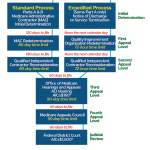The Medicare statute states that items and services provided to beneficiaries must be “reasonable and necessary” to qualify for reimbursement. Although the Medicare program determines in specific cases whether an item or service is reasonable and necessary, it also issues policies, called coverage determinations, to instruct Medicare Administrative Contractors (MACs) what to reimburse providers for. Two sources of coverage determination are available to reference for services provided to Medicare beneficiaries: National Coverage Determinations (NCDs) and Local Coverage Determinations (LCDs).
NCDs and LCDs are used by Medicare and their administrative contractors in response to a direct request by participating providers for coverage information and determination on whether services are reasonable and necessary to be covered for reimbursement. The Centers for Medicare & Medicaid Services (CMS) establishes NDC policies for items and services furnished through Medicare and awards geographical jurisdictions to the MACs that develop their LCD policies to process claims.
NCDs supersede LCDs, but LCDs expand on coverage policies for each jurisdiction, and coverage policies, including information regarding appropriate coding, credentialing, diagnostic testing and treatment, may vary. General information about Medicare coverage can be found in LCDs, and Medicare Part A/B providers are required to adhere to the LCDs in place for their particular jurisdiction. NCDs are mandated at the national level, and all MACs, carriers and fiscal intermediaries must follow these guidelines. An LCD is mandated at the MAC level and those guidelines are only applicable to that MAC’s jurisdiction. Medicare contractors develop LCDs when there is no NCD or when there is a need to further define an NCD. The guidelines for LCD development are provided in Chapter 13 of the Medicare Program Integrity Manual.
The development of an NCD generally begins with the CMS reviewing scientific literature to evaluate an issue. This process may lead to the CMS commissioning an assessment by an external contractor and referring the issue to the Medicare Evidence Development and Coverage Advisory Committee. Based on the outcome, the CMS will release a preliminary decision communication for public comment. After review of public comments and feedback, the CMS will then issue a final decision memorandum in response to the comments and publish the final decision memorandum, which is then converted into an NCD.
Also, because NCDs sometimes list only the minimum coverage requirements, it is important to look for any additional LCDs and articles from local contractors, as they usually further define the use of a service/procedure and include specific diagnoses that will support or negate coverage.
Coverage polices and determinations have a significant impact on patients when they deny access to care for certain services. According to statute, LCD determination is always based on medical necessity at the time of service and applies only to the jurisdiction served by the contractor who made the decision.
Procedural codes that are LCD dependent are noted as such in the American Medical Association’s Current Procedural Terminology (CPT) manual. If a provider is planning to submit a procedural code or Healthcare Common Procedural Coding System (HCPCS) code that’s noted to be subject to an LCD determination, the practice will need to verify the guidelines for the item or procedure prior to submitting the claim. If an item or service is new, or not defined by an NCD, the local contractor is responsible for the decision for coverage.
When neither an NCD nor LCD exists and it’s uncertain whether a service or item will be covered, but the patient desires the treatment or item, the provider must secure an advance beneficiary notice (ABN) prior to the service if the practice intends to bill the patient. For example, Medicare covers dual-energy X-ray absorptiometry (DXA) bone densitometry for certain beneficiaries, but the patient must fall into at least one of the required categories once every 23 months. The patient must be a woman whose doctor has determined she’s estrogen deficient and at a clinical risk for osteoporosis, based on her medical history and other findings; a patient with vertebral abnormalities as demonstrated by X-ray to be indicative of osteoporosis, osteopenia or vertebral fracture; a patient receiving or expecting to receive glucocorticoid therapy equivalent to an average of 5.0 mg of prednisone or greater per day for more than three months; a patient with primary hyperparathyroidism; or a patient being monitored to assess their response to or the efficacy of an osteoporosis drug therapy approved by the Food and Drug Administration. If the patient does not fit in any of the required categories or they’re within 23 months of their last diagnostic DXA, the patient needs to be informed of the guidelines, sign an ABN and pay out of pocket.
Understanding the role of NCDs and LCDs in a practice is important to the claims and billing process. In coverage determinations, contractors provide descriptions by service type and definition for individual service or item, along with indications and limitations. A review of the coding detail provided (HCPCS, CPT and diagnosis codes) can confirm services provided are accurately billed and claims are processed according to individual MAC and CMS published policy.
For questions or additional information on coding, billing and payer policies, contact the ACR practice management department at [email protected].

